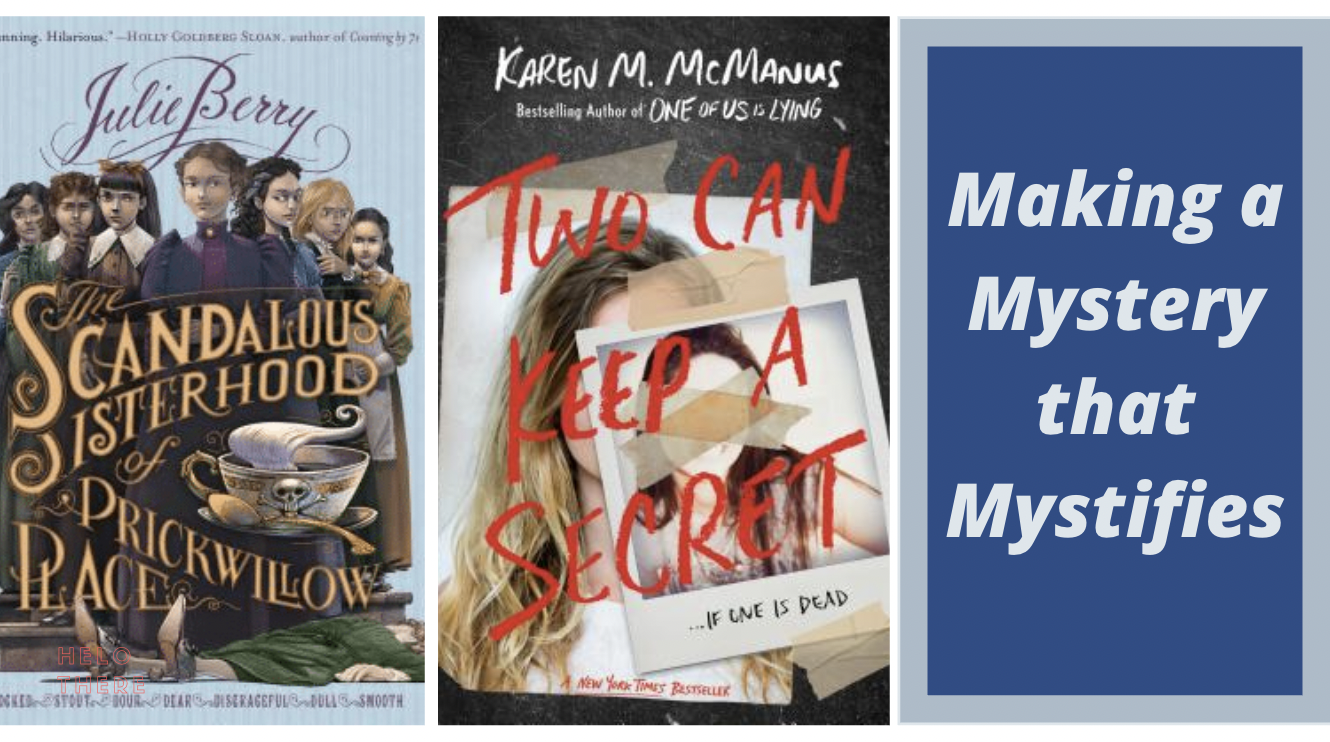craft post by Erin Nuttall
My body was as stiff as a corpse. It was after midnight—the most dangerous hour. I was alone—the most dangerous circumstance. My thirteen-year-old brain did its best to convince me that there was nothing in my small room. Nothing beyond it. That even if there were, say, a murderer, my blankets would provide cover. My bed, my faithful bed, would protect me. It always had, hadn’t it?
And the light. Surely, the murderer would be deterred by the faint flame of my flashlight. My fear had nothing to do with any nearby noises. The heaviness on my chest came not from the weight of an attacker. No, I struggled with the iron grip of the fear of the unknown and the surging desire to read on. Curse you, Agatha Christie!
The excitement of an exceptional mystery that enthralled me as a young teenager still intrigues me. Could the love of reading mysteries translate into the ability to write a good mystery? Certainly not without a plan. Just as I’ve read many good mysteries, I’ve read many more that missed the mark.
A compelling mystery must engage the reader in solving the mystery, and the best ways to do so are to 1) start the mystery off quick, 2) capture attention with consequential stakes, 3) increase tension, 4) keep the reader guessing, and 5) finish strong. Since this is a complicated subject with a lot of moving parts I’m going to split these ideas into two articles so that all the topics get the time necessary to explore them.
***Please note there are some SPOILERS for the books I discuss, Julie Berry’s The Scandalous Sisterhood of Prickwillow Place and Karen McManus’ Two Can Keep a Secret. Both of these books are a few years old so hopefully you’ve already read them. If not, be aware some plot points are given away.***
1. Get Started ASAP
The whole point of a mystery novel is the mystery. There’s no need for excessive back story, so set the crime in motion early. It would be hard to beat Julie Berry for setting the crime into motion swiftly. In her YA mystery The Scandalous Sisterhood of Prickwillow Place, Berry kills the awful Mrs. Plackett in the second paragraph, and the offing of her terrible brother, Mr. Godding, comes a mere two short paragraphs later.
Not all stories must be so quick off the block—and it must be noted this entire lack of backstory required Berry to include some basic character information in the front matter to keep readers from being totally lost—but an early start is crucial.
Another tack for getting the mystery off the ground with alacrity is to, unbeknownst to the reader, lay the groundwork for the crime while setting up the story. A way to do this: in the first scenes introduce important characters that will show up later, and drop clues and red herrings that the reader will recognize once the crime is known.
For example, in Karen McManus’ YA novel Two Can Keep a Secret, the first of several mysteries she sets up doesn’t take place until page nine, but McManus uses the first nine pages to sprinkle clues and red herrings along with the character introductions and backstories.
Both Berry and McManus get the ball rolling quickly and let the reader jump right into the juicy business of trying to solve the mystery.
2. Set the Stakes High
If the mystery is not exciting, then the reader is going to disengage and will get up to make the proverbial sandwich. Therefore mysteries frequently involve murder, kidnappings, and significant robberies (even in Middle Grade). These types of large-scale stakes immediately draw the attention of readers; no explanation is needed as to why it’s important to capture a murderer or find the kidnapped person or prevent a bomb from going off.
While it isn’t strictly necessary, when there are personal stakes for the detective, it can also increase the reader’s investment in the story. The television show NYPD Blue, for example, was ostensibly a story about a police squad solving crimes. In reality, it was the story of the redemption of Detective Sipowicz. His redemption came sometimes in spite of, sometimes because of, but always in the midst of solving crimes. But while solving the crimes drove the secondary plot, the overarching plot was the changing of the heart of this seemingly irredeemable character.
The most famous cult of personality in the detective business is, of course, Sherlock Holmes. He too had his personal failings; however, they never eclipsed the primary plot of solving the mystery. These personal faults and foibles helped endear Holmes so much to readers (and viewers) that there are dozens of Sherlocks both literal (Sherlock and Elementary) and imitations (Monk and The Mentalist). There are also Hercule Poirot, Jessica Fletcher, Veronica Mars, Thomas Magnum, and Precious Ramotswe, to name but a few detectives with their own followings.
The reason there are named detectives is that readers (and viewers) become invested in the detectives themselves and therefore in the crimes that they solve. This is true of both the characters who are detectives by trade and those who stumble upon crimes and the need to solve them is thrust upon them. The most salient feature of both styles of detective is that the more the reader is invested in the detective personally, the more they are invested in them solving the crime and the less likely they are to put down the book, even if they’re terrified, or less ideally, bored.
In The Scandalous Sisterhood, the seven main characters are not dismayed at the death of their headmistress and her brother but see it, rather, as an opportunity to be free of onerous societal restrictions. The mystery, however, causes two initial problems for them.
First, they don’t know who the murderer is (it might even be one of them). Second, the murderer is still at large and most likely will strike again. Both problems are rather dire and these stakes keep the reader invested in the girls solving the mystery. The girls have the additional motivation that if they are caught living without a headmistress (and if it becomes known that they buried their headmistress and her brother in their back garden), their future prospects are grim. They will be sent home. Or, they will be taken for the murderers and will be sent to prison. Or worse, they’ll be sent to another horrible school with a horrible headmistress and horrible girls that they don’t like.
All in all, the stakes are quite high for the sisterhood, and therefore, it ensures the reader is invested in not only the characters solving the mystery, but in their doing so in a way that allows the girls to stay together—a very high bar indeed.
3. Up the Tension
The death knell of a mystery is to let it lag. Even in a slow burn-style story, there has to be something to burn, and that something is what causes an ever-increasing tension. In The Scandalous Sisterhood, the St. Ethelreda’s School for Young Ladies has an unusual, but continuous, flow of visitors, which begins before the bodies of Mrs. Plackett and Mr. Godding are even cold. These visitors keep the story moving quickly even while each visitor ups the tension for the girls. They need to assess the situation, find clues, suss out who they can trust, and importantly keep the bodies from being discovered.
Party guests begin ringing the bell because, unbeknownst to the girls, Mrs. Plackett had planned a surprise party for her brother on the very night that turned out to be his last (Berry 15). Dr. Snelling stops by to check Mrs. Plackett’s liver (21). Mrs. Fringle injures herself and must stay overnight—in the deceased Mrs. Plackett’s bed with her (68). All sorts of visitors continue on and on and on throughout the story. And, adding to the tension for the girls–and the reader–the girls must keep up with all of the excuses and the lies they must tell in order to keep all of the visitors unaware that Mrs. Plackett and Mr. Godding have been murdered and are buried in the back garden—all while the girls continue trying to solve the mystery. The pace is hard-driving and keeps the girls, and the reader, on their toes.
In Two Can Keep a Secret, a small town is haunted by the murder of two teen girls. The first, a Homecoming Queen twenty years earlier, and the aunt of the main characters Ellery and Ezra Corcoran. The second, the Homecoming Queen only five years before who was killed in the Murderland amusement park. Neither murder was solved.
McManus has the murderer (or is it someone else?) increase the tension by mocking the public, and the reader, with threats of more murders. First, the Cultural Center’s sign is graffitied in blood-red paint that reads: Murderland the Sequel, Coming Soon (McManus 32). A mere twenty pages later, a mausoleum in the cemetery is decorated with dolls hanging by nooses and wearing prom dresses and crowns. Again, dripping red paint reads: I’m back, pick your queen, Echo Ridge, Happy Homecoming (51). Fifty pages later, more red graffiti, this time on a side of a building: Corcorans Make Killer Queens (103).
These types of taunts reference the old, unsolved murders of Homecoming Queens and hint at new murders yet to come, continuing to up the tension. Who is taunting the town? Who will be next? Who is the murderer? Can they be stopped in time?
Until next time . . .
As you start to plot your mystery story be sure to start it off with a bang, set the stakes high with both the crime and the personal stakes for the detective, and then keep upping the tension. By doing these things you can keep your reader engaged in both the story and the mystery and keep them turning pages.
In part two we’ll talk about how to keep your reader guessing–that means clues and red herrings–and how to keep the momentum going through to the end. See you then.
For more from KidLit Craft on mysteries:
Erin Nuttall holds an MFA in Writing for Children and Young Adults from Vermont College of Fine Arts and is an active member of SCBWI and ALAN. She lives outside of Chicago with her family where she writes stories for middle grade and young adult readers that offer a humorous take on friendship, identity, feminism, and romance.




COMMENTs:
0